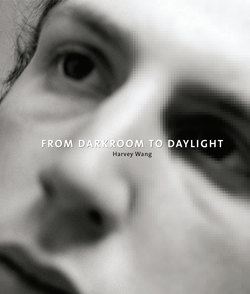Читать книгу From Darkroom to Daylight - Harvey Wang - Страница 7
На сайте Литреса книга снята с продажи.
ОглавлениеADAM BARTOS:
One of my great influences was Blowup, Antonioni’s movie. Nothing beats that fantastic sequence of watching the image come up on the paper in the darkroom, and then the way he kept enlarging and rephotographing that area, blowing it up optically, chemically, to try and discover the truth of what the image contains. I mean, punching the “plus” button on your computer? No, it’s not as cool.
I started a few years ago to photograph darkrooms when I heard about one that was closing, and all of a sudden, it clicked that—hmm, maybe I should go and make a record of that (Darkroom, Steidl, 2012). The darkroom is a metaphor for so much about art and craft, and it’s the architecture most photographers have shared, until now. There are aspects of the darkroom that are instantly familiar to us, the sound of the water running, the humidity, the clocks, the music we play in the dark….
PLATON:
The darkroom is the beginning of everything. You’re locked away. It sort of isolates you from the world around you, in a way that the computer screen does not. And it forces you to commit 100 percent to what you’re doing. There’s no point in doing anything else when you’re in the darkroom, because it’s dark. It’s just a hint of red light, and that is it. You are there to print.
SALLY MANN:
I go in the darkroom, I close the doors, and there’s the soothing sound of the water, that little gurgle, because you’re always washing. And that forgiving yellow light. Oh, it’s so calming. It’s really good for me to be in the darkroom. You’re by yourself, no one dares walk in on you. It’s perfect peace.
JOHN COHEN:
I enjoyed the process of being out in the world shooting, and then spending a lot of time in the darkroom. Really living with each print, and spending a lot of time on it, not just making it darker or lighter so much as discovering what meanings were in there.
JEROME LIEBLING:
Certain truths were given to you as a student. One was that you really created that image. The paper was given to you, but you could somehow, with your skill and sense of spirit, imbue that piece of paper with your own sense of what was there.
GEORGE TICE:
When I’m making a print I’m making a finely crafted art object. I’m not just making an image. I like my solitude. I live alone, I’ve been married three times, I have five children. The darkroom is a place where you can think, and concentrate on what you’re doing because there are a hundred things you can do wrong, and you’re trying to get them all right.
After developing my film and printing a contact sheet, I make a proof print. I have a big bulletin board downstairs where I tack prints up. Then I’ll decide what’s in, what’s out. After printing something the first time, I can usually improve on it somewhat the second or third time.
JEROME LIEBLING:
We all know the running and jumping that we do when we dodge, and we only have two hands, and you want to open this, and change that, and you can only go so far [before the time is up], and then you quit.
DAVID GOLDBLATT:
When there’s light hitting that sensitized paper, you’ve got a limited time in which to make all the changes you want to make, all the adjustments.
JOHN COHEN:
It’s kind of fun, you realize, once you’ve seen the digital thing, that when you’re up in the darkroom, you’ve got to move your hand and dodge and burn. You have so many seconds, and then it’s over. So it’s a little bit more of a performance, actually.
DAVID GOLDBLATT:
And these are the adjustments that, to me, are part of the trade. They’re not the adjustments of putting trees in where they weren’t, of taking people out, and putting them in, and that sort of thing. I’m talking about basic changes to the image to make it more consonant with my understanding of it.
PLATON:
It’s in the printing where I really learned that your skin is different from your shirt, and your shirt is different from your boots. The more contrast I give your shirt, the more I describe its material makeup; same with your skin, but your skin is much lighter than your shirt, so I can’t treat it at these contrast levels in the same way. So I started learning to cut masks out with paper, and I would lay them on the print, and I would do about 20 or 30 masks for each print. And each print would take about three days to do.
ALFRED GESCHEIDT:
My hands are all brown, my fingernails are brown from the soups [chemicals] I was using. I just accepted it as part of the discipline. I didn’t think there was any other way to do it.
RICHARD SANDLER:
Every print is different. You cannot possibly duplicate them. Every one is slightly different, and some of them are better than others, of course, and maybe you make a mistake, and out of that mistake comes something brilliant.
ALFRED GESCHEIDT:
I still think of the image coming up, and saying “Son of a bitch, I got it,” or “Nope, got to go back.”
